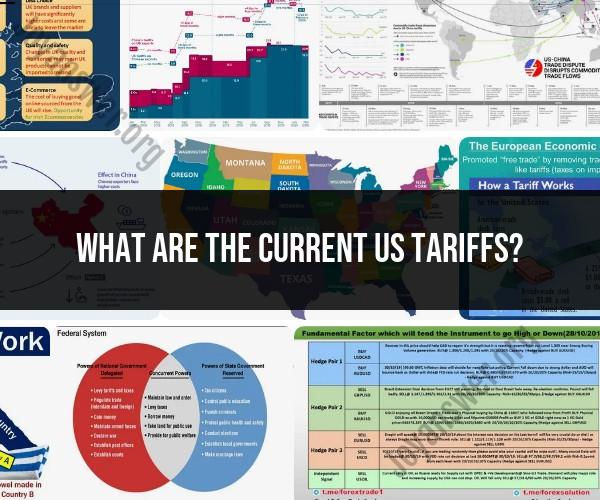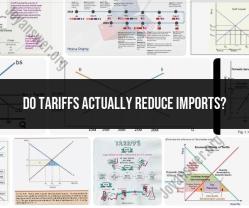What are the current US tariffs?
The specific details of U.S. tariffs, including the rates, products, and countries affected, are subject to change due to various trade agreements, negotiations, and policy decisions. I can provide you with a general overview of U.S. tariffs and the key information surrounding them:
1. U.S.-China Trade War: One of the most notable trade disputes in recent years has been the trade war between the United States and China. This conflict has resulted in a series of tariff actions and retaliatory measures. While some tariffs were reduced or suspended as part of trade negotiations, many remained in place, affecting a wide range of goods.
2. Section 301 Tariffs: The U.S. imposed Section 301 tariffs on a variety of Chinese goods in response to perceived unfair trade practices by China. These tariffs have been applied to various products, including electronics, machinery, and consumer goods.
3. Steel and Aluminum Tariffs: The U.S. imposed tariffs on steel and aluminum imports from various countries, including close allies like Canada and the European Union. These tariffs have led to trade tensions with affected nations.
4. Tariffs on Other Products: The U.S. has applied tariffs on other products and imports, including those from the European Union due to disputes related to aircraft subsidies, and tariffs on imports from India as a result of trade issues.
5. Trade Negotiations: Trade negotiations, such as those with China and other trading partners, have led to some adjustments in tariffs and trade policies. Tariff rates have been a subject of negotiation in various trade agreements and discussions.
6. Tariff Exemptions: In some cases, the U.S. government has granted exemptions or exclusions from tariffs for specific products or certain industries. These exemptions are typically granted in response to industry requests and can be temporary.
To get the most up-to-date information on current U.S. tariffs, including specific rates, affected products, and trade policy changes, it's advisable to consult official sources such as the U.S. Trade Representative (USTR) website or other government agencies responsible for trade policy. Tariffs are subject to change as trade relationships and international agreements evolve, and staying informed about the latest developments is essential for businesses and individuals involved in international trade.
Current US Tariffs: An Overview of Tariff Impositions
The United States currently has tariffs on a wide range of imports, from goods such as steel and aluminum to consumer products such as clothing and electronics. These tariffs are imposed for a variety of reasons, including to protect domestic industries from foreign competition, to raise revenue, and to promote national security.
The most significant tariffs currently in place are those imposed on imports from China. These tariffs were imposed in 2018 in response to what the US government alleged were unfair trade practices by China. The tariffs initially covered $34 billion worth of Chinese goods, but have since been expanded to cover over $350 billion worth of goods.
In addition to the tariffs on imports from China, the US also has tariffs on imports from a number of other countries, including Mexico, Canada, and the European Union. These tariffs were imposed in response to a variety of trade disputes, including disputes over steel and aluminum tariffs, digital services taxes, and aircraft subsidies.
Tariffs in the United States: The Latest Trade Policies
The Biden administration has continued to use tariffs as a tool in its trade policy. However, the administration has also taken steps to reduce or eliminate tariffs in some cases. For example, in 2022, the US and the EU reached an agreement to suspend tariffs on certain goods, including steel and aluminum.
The Biden administration has also been working to negotiate new trade agreements with a number of countries, including Japan, the United Kingdom, and Kenya. These agreements could lead to a reduction or elimination of tariffs on certain goods.
Tracking US Tariffs: Updates on Current Trade Measures
The US government publishes a number of resources on current trade measures, including tariffs. One of the best resources is the website of the Office of the United States Trade Representative (USTR). The USTR website provides a list of all tariffs currently in place, as well as information on trade negotiations and other trade-related issues.
Another good resource for tracking US tariffs is the website of the US International Trade Commission (USITC). The USITC website provides a number of tools and resources for tracking tariffs, including a tariff database and a tariff lookup tool.
Conclusion
The United States currently has tariffs on a wide range of imports. These tariffs are imposed for a variety of reasons, including to protect domestic industries from foreign competition, to raise revenue, and to promote national security.
The Biden administration has continued to use tariffs as a tool in its trade policy. However, the administration has also taken steps to reduce or eliminate tariffs in some cases. The Biden administration is also working to negotiate new trade agreements with a number of countries, which could lead to a further reduction or elimination of tariffs.
The US government publishes a number of resources on current trade measures, including tariffs. The best resources for tracking US tariffs are the websites of the USTR and the USITC.







